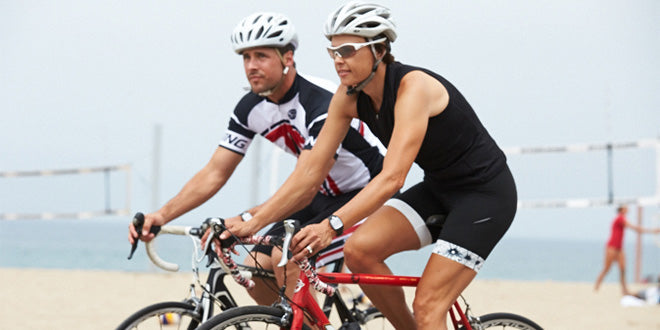For years, athletes have been told to load up on carbs before events and guzzle energy beverages or glucose gel to fuel performance. But what if endurance wasn’t predominantly dependent on muscle-glycogen utilization? What if your body could engage in prolonged exercise by utilizing more fat for energy?
It turns out that it can! However, like most performance-improving measures, it requires training. And while the majority of research shows that this kind of endurance training reduces glycogen depletion, it does not necessarily improve performance.
What the Research Shows Regarding Fat Adaptation
Numerous studies have evaluated the effectiveness of a technique called “fat adaptation” for altering fuel utilization and improving endurance. Some of these studies involve short-term fat adaptation strategies of five to six days per week on a high fat diet: 60 to 70 percent of energy intake from fat, 15 to 20 percent of energy from carbohydrates and the remaining from protein. This is not necessarily a high calorie diet. It is simply a different breakdown of the three macronutrients. During this adaptation period, athletes engage in their typical training regimen. One to two days prior to the testing, they increase the percentage of carbohydrate intake to normal or elevated levels (up to 80 percent of daily intake).
A review of research evaluating “fat adaptation” strategies published in the journal Applied Physiology, Nutrition, and Metabolism in 2011 found that this protocol increased the rate of whole-body and muscle fat oxidation while attenuating the rate of muscle glycogenolysis during endurance exercise. These results mean that the body is effectively utilizing an alternative fuel in addition to glycogen, delaying the onset of glycogen depletion (1).
In another study conducted by researchers at RMIT University in Australia (2), seven competitive athletes consumed a standard carbohydrate diet for one day, then either a high-carbohydrate or a high-fat diet of the same number of calories for six days. On the eight day, all subjects consumed a high-carbohydrate diet and rested from exercise. On the final day, they cycled for four hours at 65 percent of maximum exertion followed by a one-hour time trial. Researchers observed that power output was 11 percent higher during the time trial after fat-adaption diet than after high-carbohydrate diet. In addition, fat oxidation during exercise increased after the fat-adaption strategy and remained elevated above baseline even after one day of a high-carbohydrate diet. There was also an increase in carbohydrate availability.
Another article, published in the Journal of Sports Sciences, found that dietary fat adaptation for a period of at least two to four weeks resulted in a nearly two-fold increase in resistance to fatigue during prolonged, low- to moderate-intensity cycling. Researchers also observed that consuming medium-chain triacyglyerols (MCTs) in combination with carbohydrates spares glycogen, noting that MCTs are rapidly absorbed during exercise compared with largely unavailable long-chain fatty acids (3).
While some other studies show an increase in fat oxidation, they do not indicate an improvement in performance after fat adaptation periods compared to traditional high-carbohydrate diets, and they may actually compromise performance. A review of several studies published in the journal Sports Medicine observed that short-term fat adaptation periods (fewer than six days) were detrimental to performance at high intensities. Longer adaptation periods of up to 28 days had mixed results, either maintaining results commensurate with the control group or attenuating performance in some cases (4).
Another study published in the Journal of Applied Physiology found that the fat-adaptation strategy resulted in no difference in a 100-kilometer time trial and actually compromised performance in a 1-kilometer trial (5). Researchers speculated that this may have been due to increased sympathetic activation or altered contractile function.
Finally, in a review of literature on the subject, researchers from the University of Birmingham evaluated 48 different studies and concluded that extreme dietary and training regimes in trained athletes, whether they be high-fat or high-carbohydrate strategies, are not necessary to achieve optimal muscle glycogen stores or enhance performance.
Conclusion
So although fat adaptation strategies do significantly alter the mix of fuels used and increase the amount of fat burned during endurance exercise at low to medium intensities, this strategy has also been shown to be insignificant or nonexistent in performance enhancement compared to carbohydrate loading strategies. Competitive endurance activities (like cycling) also require one to have a “big gear”, such as surging uphill or breaking away. These higher intensity events all require the use of carbohydrates for fuel. Since fat adaptation can affect this crucial element of cycling and does not enhance prolonged performance, there appears to be no specific support to recommend such a dietary strategy.
References:
- Teo, W.K., Carey, A.L., Burke, L., Spriet, L.L., & Hawley, J.A. (2011). Fat adaptation in well-trained athletes: Effects on cell metabolism. Applied Physiology, Nutrition and Metabolism, 36(1), 12-22.
- Carey, A.L., Staudacher, H.M., Cummings, N.K., Stepto, N.K., Nikolopoulos, V., Burke, L.M., & Hawley, J.A. (2001). Effects of fat adaptation and carbohydrate restoration on prolonged endurance exercise. Journal of Applied Physiology 91(1),115-122.
- Lambert, E.V., Hawley, J.A., Goedecke, J., Noakes, T.D., & Dennis, S.C. (1997). Nutritional strategies for promoting fat utilization and delaying the onset of fatigue during prolonged exercise. Journal of Sports Sciences, 15(3),315-324
- Havemann, L., West, S.J., Goedecke, J.H., Macdonald, I.A., St. Clair Gibson, A., Noakes, T.D., & Lambert, E.V. (2000) Adaptation to a fat-rich diet: Effects on endurance performance in humans. Sports Medicine, 30(5),347-357.
- Havemann, L., West, S.J., Goedecke, J.H., Macdonald, I.A., St Clair Gibson, A., Noakes, T.D., & Lambert, E.V. (2006), Fat adaptation followed by carbohydrate loading compromises high-intensity sprint performance. Journal of Applied Physiology, 100(1),194-202.
- Jeukendrup, A. & Schweizerische, Z. (2003) High-carbohydrate versus high-fat diets in endurance sports. Sportmedizin und Sporttraumatologie, 51 (1), 17–23.
About the Author
Pamela Ellgen is a certified personal trainer with the National Academy of Sports Medicine and a paleo food blogger at PamelasModernFamilyTable.com. She is author of the book Psoas Strength and Flexibility: Core Workouts to Increase Mobility, Reduce Injuries and End Back Pain, published in February 2015, and has a passion for distilling complex scientific research into useable information for mainstream audiences. When she’s not writing, she enjoys surfing, practicing yoga and exploring the local farmer’s market.






Leave a comment
This site is protected by hCaptcha and the hCaptcha Privacy Policy and Terms of Service apply.